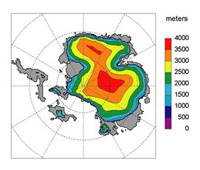Mar 1 2009
Current climate models do not match the level of polar warmth before the greenhouse-to-icehouse transition took place 34 million years ago, according to new findings by climate researchers Robert DeConto and R. Mark Leckie of the University of Massachusetts Amherst, with colleagues at Yale and elsewhere. This suggests that models we now use to predict climate change might be underestimating future polar warming.
 This diagram shows what the first (early Oligocene) Antarctic ice sheet might have looked like (about 33.5 million years ago) as global climate coole
This diagram shows what the first (early Oligocene) Antarctic ice sheet might have looked like (about 33.5 million years ago) as global climate coole
Their study of factors involved in Antarctic ice sheet formation during that transition is reported in the Feb. 27 issue of Science. In it, the geoscientists offer a fresh look at reasons for the major climate change millions of years ago and say their evidence refutes earlier theories.
DeConto and colleagues’ new temperature data and numerical climate model simulations contradict the long-held idea that global temperatures remained steady over that transition period of 34 million years ago. They argue instead that before the Southern Hemisphere ice expansion, high-latitude temperatures were about 10 degrees Celsius warmer than previously estimated. Further, they suggest that sea surface water temperature dropped by 5 to 10 degrees C during the transition.
Previous reconstructions had given no evidence of high-latitude cooling, according to Mark Pagani of Yale, but the new data demonstrate a clear temperature drop in both hemispheres. DeConto adds that the “substantial cooling” in both Northern and Southern high latitudes at the time suggest a decline in atmospheric carbon dioxide levels drove the transition, rather than changes in ocean circulation caused by the opening of Antarctic ocean gateways. This is in keeping with earlier numerical climate and ice sheet modeling by DeConto and David Pollard of Pennsylvania State University suggesting that declining greenhouse gas levels triggered the Antarctic glaciation.
Data from the current study are in general agreement with climate models suggesting that Antarctica froze in response to declining carbon dioxide levels and hence cooling, DeConto adds, yet “significant inconsistencies remain.” Most notable are the extremely warm high latitude temperatures seen before the Antarctic glaciation event of 34 million years ago and evidence that they were also related to greenhouse gas levels.
Temperatures in some regions were surprisingly higher just before the Antarctic glaciers formed than current climate models predicted, the authors point out. As DeConto notes, “this is a serious concern” because if we’re underestimating future warming over the poles, current estimates of future sea level rise from melting ice sheets and glaciers might also be far too conservative. Today, the Antarctic and Greenland Ice Sheets contain enough ice to raise global sea level more than 70 meters if melted. The findings have important implications for predicting future climate change, including that we may be underestimating polar warming.
DeConto and colleagues’ conclusions are based on sea-surface temperature proxies, that is, calculations of ancient ocean temperatures derived from organic molecules from tiny marine creatures preserved in ocean sediments. For their new analyses, the researchers had access to deep sea sediment cores collected by the Ocean Drilling Program (ODP) and other international marine drilling programs that study Earth history. The overall study was supported by the National Science Foundation.
The current work also questions the idea that ice expansion occurred in the Northern Hemisphere at the same time as the Antarctic sheets grew. Instead, climate and ice sheet modeling by DeConto and others reported in an earlier Nature paper suggests that glaciation in both hemispheres was unlikely.
Overall, by identifying the critical variables at work during that transition, such as greenhouse gas concentration and sea temperatures, and fitting them into an accurate model, the climate scientists hope to create a more robust tool for understanding the central factors affecting climate change in the future.
Other investigators on the research team are Zhonghui Liu, Mark Pagani and David Zinniker at Yale, Matthew Huber of Purdue University, Henk Brinkhuis at Utrecht University, and Sunita R. Shah and Ann Pearson at Harvard. In addition to NSF support, the study was funded by Yale University and computation resources were provided by the Rosen Center for Advanced Computing at Purdue.